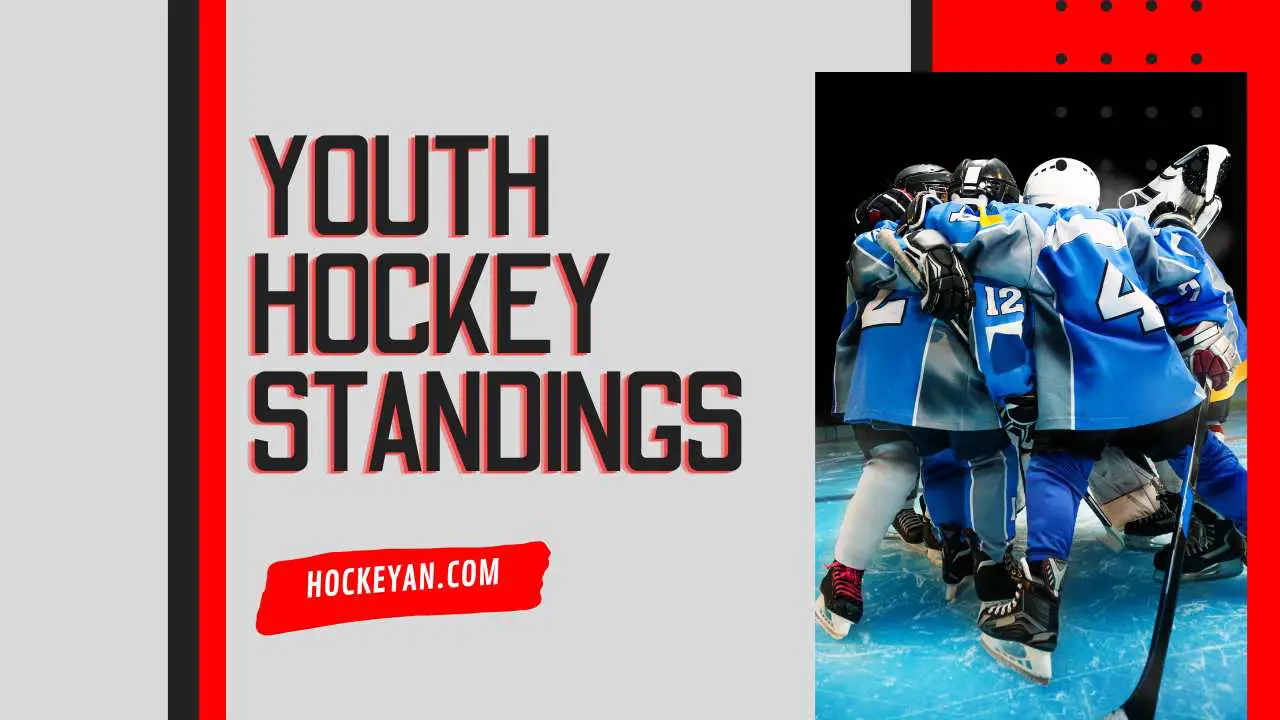Check out Youth Hockey Standings our website for comprehensive For letest update. Stay informed on all the latest scores and rankings.
The sheer excitement of youth hockey games, the deafening cheers that echo around the rink, and the suspense that comes with every rapid dash made toward the goalpost. Whether you’re a coach, a parent, a player, or an ardent fan, keeping track of the ever-changing youth hockey league standings can be as thrilling as the game itself. It all starts here, from learning about the teams battling it out on the ice to understanding the intricacies that determine their position on the leaderboard.
“In this beautiful sport, every team, every game, and every goal matters, contributing to the grandeur of the overall tally. It’s the small shifts that orchestrate the big picture.” – An anonymous hockey enthusiast.
In this article, we will provide you with an updated overview of the current season’s youth hockey standings. We will delve into the victories, the losses, the ties, the goals scored, and the goals let in that paint a unique picture of each team’s journey. And remember, the thrill isn’t solely about who comes first but also about the passion, dedication, and teamwork we witness every day on the ice rink. Stick around to catch the latest, all the highs and lows, and unparalleled excitement right here.
Understanding the Basics of Youth Hockey Standings
Now that we’ve covered the basics let’s delve a little deeper into how the youth hockey standings play out during the season. One important factor to consider is the size of the team. Perhaps you’re thinking about a very young team, where the number of players is less compared to a full-fledged adult team. This is where the strategies and competencies of the coach play a crucial role.
Take, for example, the preseason games. These games are very important as they provide a unique opportunity to test the waters, understand each player’s capabilities, and work on their strengths and weaknesses. Let’s talk about a Saturday doubleheader game. The team that pulls off a resounding 15-1 victory has displayed a strong offense and has undoubtedly proved their mettle. However, the truly exceptional team can replicate this victory. For example, if they clinch an 8-2 victory in another game, it demonstrates not just the players’ abilities but also the effective leadership and strategic planning capabilities of the coach.
On this note, let’s mention Coach Mike Armstrong, who once said, “Every game is a fresh start. Half of my kids may not be the strongest skaters, but they are quick learners with hearts full of passion for the game.” Coach Armstrong is respected for his successful coaching approach, which focuses on nurturing the individual strengths and potential of each player.
In conclusion, understanding youth hockey standings isn’t just about the scores. It’s about acknowledging the grit, determination, and team spirit that these young players bring to the ice. Yes, wins and losses matter, but at the end of the day, it’s about fostering a love for the game and developing skills that these young athletes will carry with them throughout their lives.
Significance of Points and Ties in Youth Hockey Standings
With Coach Mike Armstrong at the helm, the Young Lions’ preseason games have painted a very promising picture for the upcoming youth hockey season. The Lions, comprised mostly of very young players, are a testament to how age and size are not always the prime determinants of an athlete’s capabilities. They’re a smaller team compared to many of their competitors – but they pack quite a punch.
After an overwhelming 15-1 victory against the Giants during their Saturday doubleheader, the Lions proved their mettle further with an 8-2 victory against the Small Challengers. These victories have laid a solid foundation for the team to build upon in the upcoming main season.
What’s fascinating about youth hockey, particularly in the case of Coach Armstrong’s team, is the significant improvement that can be seen game over game. We should remember, half of these kids are just starting to understand the intricacies of an ice hockey game, the positioning, the teamwork and the stamina needed. Despite this, they are dominating the ice with an inspiring blend of skill and strategy.
The Greater Toronto Hockey League (GTHL) is the largest minor hockey league in the world, with over 40,000 participants each year. Imagine stepping onto the ice, your blades gliding over the frosty surface, the sound of cheers echoing through the arena. Now, picture you’re not just any player but a member of one of these youth hockey teams. It’s more than just a game; it’s a passion that burns brightly in the hearts of thousands of young athletes.
With an impressive variety of teams, ranging from the diminutive ‘mites,’ cohorts of very young players still finding their ice legs, through to the ‘midgets,’ teenagers showcasing their athletic prowess, there’s a spot for everyone in the GTHL. It’s a melting pot of talent, where potential superstars are born, and legends are made.
For many of these young athletes, their first taste of competition comes in the form of preseason games, a crucial period of development and opportunity. It’s a time when skills are developed, teams are consolidated, and lifelong friendships are formed. Not to mention, it’s a playground where Coach Mike Armstrong, a veteran of youth hockey, nurtures and molds these aspiring athletes.
One such team, a scrappy group from the suburbs, emerged as underdogs in a Saturday doubleheader. They were smaller and younger than most, with ‘half of my kids’ yet to make their mark, according to Coach Armstrong. However, their 15-1 victory in Vernal, Utah, turned heads as they shot up in the standings, proving that size doesn’t always matter in the chase for ice glory.
The world of youth hockey is a wonderful confluence of skill, teamwork, passion, and sheer determination. The thick, sturdy boards of the rink serve as the borders between ordinary life and the thrilling world of hockey. Each goal scored, each save made, each victory celebrated – they all count towards the season’s ultimate prize. So, as the standings shuffle and reshape after each game, remember – every stride, every shot, every shared laughter in the locker room – it’s all part of the beautiful game that is GTHL youth hockey.
What does ‘GP’ mean in youth hockey standings?
As we delve deeper into the nitty-gritty of youth hockey standings, you might have noticed this abbreviation ‘GP’ appearing frequently in the statistics. ‘GP,’ or ‘Games Played,’ refers to the number of games a team or an individual player has participated in during a particular season or tournament. It’s a fundamental component in understanding the performance metrics in youth hockey.
Pay attention when looking through these numbers, as they include not only regular season games but also any preseason and playoff games that may have taken place. Essentially, the ‘GP’ count offers a comprehensive representation of the team’s engagement throughout the season.
For instance, consider a very young team participating in a Saturday doubleheader, where they stunningly scored a 15-1 victory in the morning and followed it with an impressive 8-2 victory in the afternoon match. Both of these matches get added to their’ GP.’ As Coach Mike Armstrong often says, “Every single match, no matter win or loss, adds up in the ‘GP’ count, and it reveals the true extent of our athletes’ capabilities.”
As a note of interest, in smaller teams where each player gets maximum playtime, the ‘GP’ of the team collectively can provide insights into individual player’s exposure too. As you navigate through the youth hockey landscape, you might hear phrases like, “Half of my kids have a ‘GP’ of 10 this season”, indicating their immense participation.
So next time when you’re sifting through the youth hockey standings, give a glance at the ‘GP’. It’s more than just a number; it contributes to the thorough analysis of the team’s performance, players’ involvement, and their overall growth in the sport of ice hockey.
What is the difference between ‘GF’ and ‘GA’ in youth hockey standings?
In world of youth hockey, ‘GF’ and ‘GA’ play a significant role in determining a team’s standing. ‘GF’ stands for ‘Goals For,’ which simply measures the total number of goals a team has scored in their games. It’s an indicator of a team’s offensive capabilities, reflecting their efficiency to seize scoring opportunities and translate them into points on the scoreboard.
On the flip side, ‘GA,’ or ‘Goals Against,’ calculates the total number of goals a team has conceded during their matches. A low GAc score speaks volumes of a team’s solid defense strategy, showcasing their ability to restrict the opposing team’s scoring against them.
For instance, consider a youth hockey team that has a strong offense and a decent defense. They may have a GF that’s notably higher than their GA. This difference is a testament to their robust attack and respectable defense strategy. As an example, let’s take a look at a recent Saturday doubleheader. Coach Mike Armstrong’s very young team reported a 15-1 victory in the first game and an 8-2 triumph in the second, led by a squad where half of the players were still learning the ropes. These victories are mirrored in their GF and GA scores, and it’s this kind of dynamic playing that keeps fans on the edge of their seats.
Remember, though, while ‘GF’ and ‘GA’ are significant, they don’t tell the entire story. Other factors, such as the number of games played (GP), points, ties, and the athletes’ capabilities, also play a vital role. It’s essential to consider all these elements when evaluating a team’s standing in youth hockey games. Your understanding of these terms and more can help you appreciate the sport’s intricacies and see the bigger picture when it comes to youth hockey standings.
Why are tie games important in youth hockey standings?
You might be thinking, “Why does a tied game matter so much?” Well, let’s dive into it.
Tie games are crucial in youth hockey, particularly because they demonstrate the team’s resilience and ability to hold their ground against the opposition. They might not secure the win, but the tied result signifies a match played with fierce competition, offering valuable lessons for the young athletes. It’s often an excellent indicator of a team’s defensive skills and its ability to take on stronger, more experienced groups of players.
Let’s take an example of our very own small team experiencing a Saturday doubleheader. Imagine Coach Mike Armstrong’s players, just half of his kids, stepping onto the ice for a preseason game. They may not defy all odds to pull a 15-1 or 8-2 victory like the bigger teams, but they can learn and grow significantly from a tie.
A tied game turns out to be a balanced competition, offering every player to study their adversary’s tactics and learn crucial game strategies. These experiences, while they might not skyrocket them up to the top of the standings, can be instrumental in enhancing the athletes’ capabilities hugely. Remember, building a strong team is more about improvement and less about a spotless winning streak.
Therefore, those tie games that might confuse you initially do hold immense value. They contribute to the team’s learning curve, leading them to emerge stronger and more adept in their game performance. So, next time you see a ‘T’ in the standings, feel proud about it!
What is the role of overtime losses in youth hockey standings?
First off, let’s put all the cards on the table. In the world of youth hockey, just like in professional leagues, overtime losses, often referred to as ‘OTL,’ pack quite a punch. Why? Although they’re still technically losses, they reflect a match where the athletes gave their all, stretching their capabilities to the limit in an attempt to clinch the victory. The game may not have swung in their favor, but their grit and determination earned them a point. Such as
- Overtime losses occur when a game is tied at the end of regulation time and extends into an overtime period. The team that doesn’t score in this period suffers an overtime loss.
- In youth hockey standings, overtime losses are usually awarded with a point. This is in contrast to a regulation loss, which does not yield any points to the losing team.
- Overtime losses can have a significant impact on a team’s standing, especially in tight rankings where one or two points can mean the difference between several positions.
- Considering overtime losses, preseason games or a Saturday doubleheader can be key turning points in a season, helping smaller and younger teams accumulate points against stronger opponents.
- Coaches like Mike Armstrong often use these tight games as learning opportunities. Overtime pressure exposes young athletes to stressful situations, testing their capabilities and resilience.
- However, overtime losses can also be demoralizing. For example, a promising 8-2 victory can quickly turn into a defeat, causing disappointment among the young team members.
- Coach Armstrong once admitted, “Half of my kids learned more from an overtime loss than from our 15-1 victory.” It shows that the experience gained from overtime losses can be instrumental in honing the skills and character of youth hockey players.
What is the impact of a team’s age group on youth hockey standings?
If you’ve ever observed the kaleidoscope of youth hockey, you’ll realize that age groups play a critical role in the evolution of the game, with each age group creating its own dynamic. It’s a determinant factor in the standings, too.
Picture this: a very young team stepping onto an ice hockey field for the first time, trying to master the intricate drills and maneuvers. Their performance and standings are, naturally, impacted by their age and associated athletic capabilities. The younger the team, the more formative their skills, often leading to a lower ranking in the standings compared to older, more experienced teams.
As teams move up in age brackets, the game increases in intensity, skill level, and competition. Like Coach Mike Armstrong always says, “Half of my kids who started out in the smallest teams have now been shaped into seasoned players, contributing significantly to their standings.”
However, even a smaller team can defy the odds and shine in the standings. Take, for instance, the preseason games where a team of young players clinched an impressive 15-1 victory. Or the unforgettable Saturday doubleheader, where they celebrated an emphatic 8-2 victory.
So remember, age groups can certainly impact youth hockey standings, but as these young athletes grow, improve their skills, and gain experience, they can turn the tide in their favor. And that, dear reader, is what makes the world of youth hockey so exciting and unpredictable.
Question And Answers
Who are the top-performing youth hockey teams currently?
The current top-performing youth hockey teams are diverse, hailing from various regions across the country. One of the standout teams is the Detroit Little Caesars, a team known for their aggressive and strategic gameplay. Their consistent performance in the league is a testament to their dedication and hard work.
What criteria are used to determine the youth hockey standings?
Another key factor in determining youth hockey standings is the goal differential, which is the difference between the number of goals a team has scored and the number of goals they have conceded. A higher goal differential indicates a stronger team performance and can be used as a tiebreaker if two teams have the same number of points.
What recent changes or trends have been observed in the youth hockey standings?
In recent years, there has been a noticeable shift in the standing of youth hockey, with certain teams consistently outperforming others. This trend is often attributed to the increased emphasis on skill development and training at a young age. Teams that have invested in quality coaching and player development programs are seeing the fruits of their labor reflected in the standings.
Who are the notable players in the current youth hockey standings?
While it’s important to note that youth hockey standings can vary greatly depending on the region and league, there are certainly some standout players making waves in the current season. One such player is Jack Hughes, a center from the United States who has been turning heads with his exceptional playmaking abilities and scoring prowess.
What impact do the current youth hockey standings have on the overall youth hockey scene?
The current youth hockey standings have a significant impact on the overall youth hockey scene. They serve as a barometer of team performance, indicating which teams are leading and which ones need to improve. This can influence the strategies and training regimes of teams as they strive to climb higher in the rankings.
Final Thought
Get real-time updates on youth hockey standings. Visit our website. Before we wrap things up, let’s take a brief look at a recent revelation in the youth hockey scene. It’s common knowledge that size does matter in a youth ice hockey game. Yet, in an unprecedented display of skill, a smaller team from Vernal, Utah, proved otherwise. They may be young and less experienced, but the resistible force they brought on the ice surprised everyone.
Under the sterling guidance of Coach Mike Armstrong, this team demonstrated that passion, discipline, and sheer hard work can significantly tilt the scales in their favor. Despite half of his team being younger than their opponents, Armstrong ardently believed in his athletes’ capabilities – and they didn’t let him down.
The team conveyed this belief in the most compelling way possible, with successive victories of 8-2 and 15-3 during a Saturday doubleheader. These wins certainly caught everyone’s attention, proving that age isn’t always the best determinant of skill or potential in youth hockey standings.
So, remember to play with verve, not just for the points, but for the love of the game. That’s how you truly win, not just in hockey but also in life. On that thought, we wrap up our venture into understanding youth hockey standings. Keep these insights in mind, and let them guide you in appreciating the intricacies of the game!




